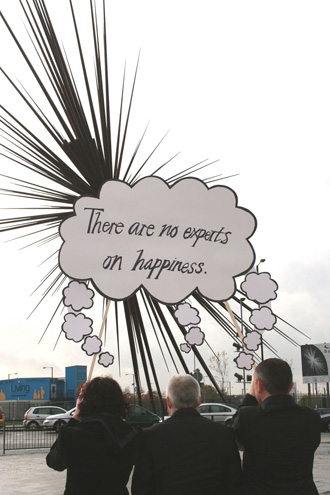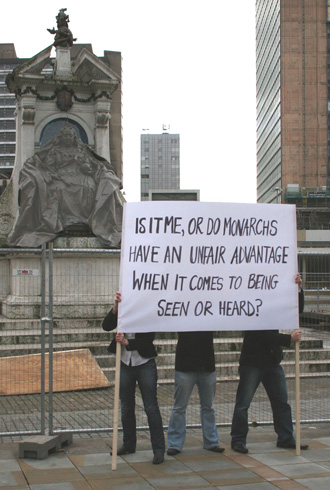On April 11 in North Carolina, Glenn Harper, Editor of Sculpture Magazine and Bill Thompson, Editor of Landscape Architecture, and I meet to kick off the “Public Art 360” Conference. Click Here to Attend. In the next few weeks, I will publish some of my letters to Harper and Thompson in preparation for the dialogue.
Once in my life, I gave the same ten minute talk back to back. The same ideas were written for different audiences: 1. architects and 2. buyers of architect’s services. Everything changed.
Like the other public arts – movies, architecture, landscape, graphic design and fashion -, public art has extremely different conceptual structures for the visual or cultural critic and for the casual, yet serious observer or participant. And in the middle is the third point of view: the public buyer of public art.
Visual/Cultural Critic: Very little writing. Most serious writing focuses on temporary works that engage the social/cultural connect of the physical place or community. Almost no serious writing on permanent works except when prominent museum artists are commissioned. But this is also rare and many of the museum artists ignore the context in permanent works. The top professional public artists are more likely to receive critical assessment from the design critics (architecture, landscape, city planning) than art critics.
Casual, yet Serious Observer: A lot of published writing in local newspapers and online that focuses on the person of the artist, the method by which the artwork came into being and the opinions of citizens and visitors regarding the artwork. Generally if the artist is known personally and the making of the art was participatory, the opinions will be positive. If the work was selected and installed, the story will be initiated by negative opinions. Ignoring the “government should not spend $$ on art or overpaying for art”, the negative opinion is “Not appropriate to this community” relating to the content or specific execution of that content. Another true and valuable concern of the casual observer: the very limited government dollars for art should be spent intelligently.
Public buyer of public art: The buyers started as an introduction of museum art to the general public (education function) and enhancing our public spaces with contemporary artwork (visual function) as had been typical of Roman culture and the neo-classical plaza and city design. In the 70’s buyer’s tried homemade work from the community as did the landscape architects. In the mid-80s, the buyer’s changed from neo-classical role to a more universal role of decorating the architecture in collaboration with post-modernism. In the mid-90’s, the buyers started purchasing from “professional public artists”. Today, enhancing the pedestrian experience dominates plus the buying civic icons of a grandscale for the tourist photograph.
As I look over the list above, I realise that I write from the position of the public buyer of public art. What are new products and new methods? Who has a fresh way of thinking about public art? What intellectual framework exists for public art evaluation? Joyful and angry observations. When my blog sparks a dialogue, it is usually about the validity of the method or elements of the evaluation.
Who is writing for the casual but serious observer? Is everyone ignoring the client? Or is the “general” client an impossible task when the functional and fiscal excuses are removed? Does the best public art only appear where a sub-group of the general public is identified as the client and that is OK within the local political system?

FREEE on Thomas Heatherwick sculpture in UK.
For further thoughts, see the dialogue on IXIA, public art think tank, in the UK. David Patten on the failure of public art agencies to let artists fully participate in the early stages of facility planning despite the appearance of participation. The FREEE artists have fun providing labels for public art. Lorraine Leeson, a community oriented public artist, creates the best list of myths and hopes related to public art.
Also some good commentary among the commenters at Cyburbia blog: Questioning Public Art.

FREEE on Queen Victoria in the UK
LATE ADDITION
The Arizona Republic has created an online opinion of 20 works created for Phoenix since 1988. After you vote for each work, you can see the results. All works are recieving supporting from greater than 50% of the voters.
Here is the Link to the Vote. Here is the Link to main article.
SEE GOOD COMMENTARY BY RIES IN THE COMMENTS.
Subscribe to Aesthetic Grounds Bi-Weekly Summary:

Ries Writes:
This is an interesting conundrum.
In the last 30 years of making public art, I have dealt with a wide range of “buyers” of public art- professional arts administrators, mostly.
Some great, some not so good.
The best ones have had art training- either as artists themselves, or a background in art history.
The worst have been project managers from the construction industry- you would be surprised how many public art programs around the country are managed, day to day, by people like this. They are nice folks, who are good with paperwork, and prompt to return calls- but they know, and generally care, very little about art- their job is to make sure that, just like buying concrete or office furniture, the art purchasing project is on time, on budget, and has all the necessary forms filled out. In situations like this, bringing up critical thinking about art is met with blank stares.
But even with the experienced, professional administrators with an arts background, asking them to think critically about the art they are buying is often impossible- not that they, personally, dont have opinions, of course they do.
But the role of a good public art administrator is to convene a jury, usually with community or building user representatives, engineers, architects or landscape architects, city government people, and the nominal “artist” who is supposed to give the artistic viewpoint some voice. Then, the administrator, usually in a nonvoting position, moderates the selection process, and then, regardless of who is selected, and how the administrator feels personally about their artwork, they must work with that artist, cordially and professionally, for 2 to 5 years, on average.
The administrator is stuck with the choice, and must make the best of it. They are required by their job to be upbeat about the selection, to defend it publicly, to be cheery and happy about it. And often, they become personal friends with the artist, and like them a lot, regardless of how they feel about the art. A good administrator will not admit to any critical feelings about the art, especially in public.
And do we really want it any other way?
There simply is no room for administrators to make critical judgements. They are, as I am sure you know, merely servants to the process.
I have served on public art selection juries- and usually, the push pull between the architects, who want the least amount of artwork, since, in their minds it detracts from the abstract beauty of their own work, versus the government representatives, who want, above all else, no controversy or bad press, results in innocuous, conservative choices.
That which offends the fewest often gets chosen.
Very very rarely, there are situations where a strong minded arts administrator, with art education, can directly choose artists, and sometimes great work results. And sometimes administrators can subtly affect the pool of artists, or the guidelines, or the locations, to help get good choices.
However, this is not “fair”, nor is it often legal, given open meeting, government contracting, equal opportunity, and other laws that affect all spending of public money.
So where, I ask, is the possibility for the kind of intelligent curating of public art you suggest?
Is the current selection process at fault? (I think it is, obviously)
Can it be changed?
Can it be changed without giving undue power to individuals, who may just pick their friends, or their own tastes?
I, too, often lament how boring, how inbred, how conservative and often meaningless many public art projects are- some done by very good friends of mine.
I am very interested in ideas to get better results, aside from just hiring the best administrators we can find, and allowing them to work their own particular systems as well as can be done.
Weiss Responds
Excellent summary of the situation of the arts savvy public art administrator.
The professionalization of the public artists creates a problem for the public art administrator. With so many experienced artists in the United States, it is very hard to argue in a public setting that some other kind of art should be selected. When non-professional public artist is hired, local artist participation is the rationale.
I am going to send your comments off to Australia and the UK where a different system can operate. The standard American system is not mandatory and is sometimes modified. In Palm Beach Gardens, Florida, the government hired a museum curator through an RFQ process. He selected the shortlist of artists and strongly argued for the most appropriate. In Broward County, “Open Office” museum exhibition designers developed public art master plan with specific artists in mind and then were permitted to be a vocal advisor during the panel process. The University of South Florida has a professional curator as the administrator that has strong influence on the selection. Special projects, like “Light Up Tampa” in 2006 or “In Public” in Seattle in 1990, frequently lead to the dominance of curators in the selection process.
Every administrator – knowledgeable or not in art – could identify a variety of projects each year where curators and other artistic risk takers led the selection process. But the City Managers and Public Art Committees need to see the value. A difficult tasks in face of so many talented public artists.